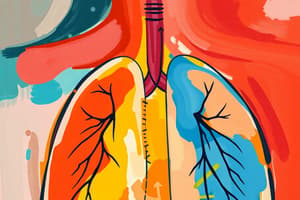Podcast
Questions and Answers
What is the primary physiological distinction between ventilation and respiration?
What is the primary physiological distinction between ventilation and respiration?
- Ventilation is the mechanical process of air moving in and out of the lungs, whereas respiration is gas exchange. (correct)
- Respiration is controlled voluntarily, but ventilation is an involuntary process.
- Ventilation involves gas exchange at the cellular level, while respiration is the mechanical movement of air.
- Respiration includes both internal and external processes, while ventilation is solely an external process.
Which of the following best describes 'external respiration'?
Which of the following best describes 'external respiration'?
- The utilization of oxygen by cells to produce energy.
- Gas exchange between air in the alveoli and blood in pulmonary capillaries. (correct)
- The process of inhaling oxygen from the atmosphere into the lungs.
- Gas exchange between the blood and tissue cells in systemic capillaries.
A nurse is assessing a client for signs of inadequate oxygenation. Which of the following is an early indicator?
A nurse is assessing a client for signs of inadequate oxygenation. Which of the following is an early indicator?
- Restlessness and confusion. (correct)
- Bradypnea with shallow breaths.
- Cyanosis around the lips and nail beds.
- A consistent SpO2 reading below 90%.
What is the primary nursing intervention to improve ventilation for a client in the early stages of hypoxemia?
What is the primary nursing intervention to improve ventilation for a client in the early stages of hypoxemia?
Which of the following is considered a source for supplemental oxygen in a healthcare setting?
Which of the following is considered a source for supplemental oxygen in a healthcare setting?
When initiating oxygen therapy with a portable tank, what essential safety step must be performed before attaching the delivery device to the client?
When initiating oxygen therapy with a portable tank, what essential safety step must be performed before attaching the delivery device to the client?
Which oxygen delivery device is most appropriate for a client requiring a precise concentration of oxygen?
Which oxygen delivery device is most appropriate for a client requiring a precise concentration of oxygen?
What is a potential hazard associated with administering high concentrations of oxygen?
What is a potential hazard associated with administering high concentrations of oxygen?
Which therapeutic breathing technique is designed to prolong exhalation and is particularly helpful for clients with COPD?
Which therapeutic breathing technique is designed to prolong exhalation and is particularly helpful for clients with COPD?
What is the primary purpose of incentive spirometry?
What is the primary purpose of incentive spirometry?
Which of the following is a gerontologic consideration regarding oxygenation?
Which of the following is a gerontologic consideration regarding oxygenation?
In arterial blood gas (ABG) analysis, PaO2 measures which of the following?
In arterial blood gas (ABG) analysis, PaO2 measures which of the following?
During inspiration, what physiological change occurs in the thoracic cavity?
During inspiration, what physiological change occurs in the thoracic cavity?
What is the purpose of performing an Allen test prior to arterial puncture for ABG sampling?
What is the purpose of performing an Allen test prior to arterial puncture for ABG sampling?
Which of the following factors can cause an inaccurate pulse oximetry reading?
Which of the following factors can cause an inaccurate pulse oximetry reading?
What is the rationale for using adhesive nasal strips to improve oxygenation?
What is the rationale for using adhesive nasal strips to improve oxygenation?
For a client with chronic lung disease, administering high percentages of oxygen carries which potential risk?
For a client with chronic lung disease, administering high percentages of oxygen carries which potential risk?
Which mask is designed to deliver the highest concentration of oxygen without mechanical ventilation?
Which mask is designed to deliver the highest concentration of oxygen without mechanical ventilation?
What is the function of the water-seal chamber in a chest tube drainage system?
What is the function of the water-seal chamber in a chest tube drainage system?
What does 'tidaling' in the water-seal chamber of a chest tube drainage system indicate?
What does 'tidaling' in the water-seal chamber of a chest tube drainage system indicate?
Which of the following is a safety measure when administering oxygen?
Which of the following is a safety measure when administering oxygen?
A client using a CPAP mask for sleep apnea is experiencing skin irritation on the nasal bridge. What is an appropriate nursing intervention?
A client using a CPAP mask for sleep apnea is experiencing skin irritation on the nasal bridge. What is an appropriate nursing intervention?
What is the benefit of using a BiPAP machine over a CPAP machine for some clients with sleep apnea?
What is the benefit of using a BiPAP machine over a CPAP machine for some clients with sleep apnea?
In the context of oxygen therapy, what does FiO2 represent?
In the context of oxygen therapy, what does FiO2 represent?
Which of the following is an advantage of using a liquid oxygen unit for home oxygen therapy?
Which of the following is an advantage of using a liquid oxygen unit for home oxygen therapy?
What is the recommended minimum flow rate for a simple mask to prevent carbon dioxide rebreathing?
What is the recommended minimum flow rate for a simple mask to prevent carbon dioxide rebreathing?
Which of the following clients would be most appropriately managed with a nasal cannula?
Which of the following clients would be most appropriately managed with a nasal cannula?
What is the rationale for rotating a collected ABG specimen immediately after drawing it?
What is the rationale for rotating a collected ABG specimen immediately after drawing it?
Which of the following positions is best described as a seated position where the client leans forward with arms supported, to aid breathing?
Which of the following positions is best described as a seated position where the client leans forward with arms supported, to aid breathing?
What is the primary reason for humidifying oxygen when administering it at higher flow rates?
What is the primary reason for humidifying oxygen when administering it at higher flow rates?
Flashcards
Inspiration
Inspiration
The process of breathing in.
Expiration
Expiration
The process of breathing out.
External Respiration
External Respiration
Exchange of oxygen and carbon dioxide in the lungs.
Internal Respiration
Internal Respiration
Signup and view all the flashcards
Hypoxemia
Hypoxemia
Signup and view all the flashcards
Hypoxia
Hypoxia
Signup and view all the flashcards
Arterial Blood Gas (ABG)
Arterial Blood Gas (ABG)
Signup and view all the flashcards
Pulse Oximetry
Pulse Oximetry
Signup and view all the flashcards
High Fowler Position
High Fowler Position
Signup and view all the flashcards
Tripod Position
Tripod Position
Signup and view all the flashcards
Orthopneic Position
Orthopneic Position
Signup and view all the flashcards
Deep Breathing
Deep Breathing
Signup and view all the flashcards
Incentive Spirometry
Incentive Spirometry
Signup and view all the flashcards
Pursed-Lip Breathing
Pursed-Lip Breathing
Signup and view all the flashcards
Diaphragmatic Breathing
Diaphragmatic Breathing
Signup and view all the flashcards
Nasal Strips
Nasal Strips
Signup and view all the flashcards
Oxygen Therapy
Oxygen Therapy
Signup and view all the flashcards
Flowmeter
Flowmeter
Signup and view all the flashcards
Oxygen Analyzer
Oxygen Analyzer
Signup and view all the flashcards
Humidifier
Humidifier
Signup and view all the flashcards
Nasal Cannula
Nasal Cannula
Signup and view all the flashcards
Simple Mask
Simple Mask
Signup and view all the flashcards
Partial Rebreather Mask
Partial Rebreather Mask
Signup and view all the flashcards
Nonrebreather Mask
Nonrebreather Mask
Signup and view all the flashcards
Venturi Mask
Venturi Mask
Signup and view all the flashcards
Oxygen Tent
Oxygen Tent
Signup and view all the flashcards
Oxygen Toxicity
Oxygen Toxicity
Signup and view all the flashcards
Positive Airway Pressure
Positive Airway Pressure
Signup and view all the flashcards
Water-Seal Chest Tube Drainage
Water-Seal Chest Tube Drainage
Signup and view all the flashcards
Hyperbaric Oxygen Therapy
Hyperbaric Oxygen Therapy
Signup and view all the flashcards
Study Notes
- Oxygenation is essential for life, as each cell uses oxygen to metabolize nutrients and produce energy
- Without oxygen, cell death occurs rapidly
Learning Objectives
- Explain the difference between ventilation and respiration
- Differentiate between external and internal respiration
- Name methods for assessing the oxygenation status of clients at the bedside
- List signs of inadequate oxygenation
- Name nursing interventions that can be used to improve ventilation and oxygenation
- Name sources for supplemental oxygen
- Identify items that may be needed when providing oxygen therapy
- List common oxygen delivery devices
- Discuss hazards related to the administration of oxygen
- Describe additional therapeutic techniques that relate to oxygenation
- Discuss facts concerning oxygenation that affect the care of older adults
Gerontologic Considerations
- Age-related changes affect respiratory function in older adults
- Functional changes include diminished cough and gag reflexes
- Increased use of accessory muscles for breathing
- Diminished efficiency of gas exchange occurs in the lungs
- Increased mouth breathing and snoring may occur in older adults
- Lung volumes change, decreasing efficiency and increasing energy expenditure
- Restlessness or confusion needs careful assessment to differentiate signs of inadequate oxygenation from delirium or dementia
- Encourage older adults on home oxygen to socialize to prevent isolation
- Teach older adults and caregivers how to use portable oxygen equipment
- Assess skin behind the ears for breakdown from oxygen tubing
- Older adults with weight loss or without dentures may not get an adequate facial seal with a mask
- Advise older adults to receive annual influenza and pneumonia immunizations
Anatomy and Physiology of Breathing
- Lung elasticity allows them to stretch during inspiration and return to a resting position after expiration
- Ventilation (air movement in/out of lungs) facilitates respiration (O2 and CO2 exchange)
- External respiration occurs in the alveoli between alveolar and capillary membranes
- Internal respiration happens at the cellular level involving hemoglobin and body cells
- Increased carbon dioxide and hydrogen ions stimulate breathing
- Ventilation results from pressure changes in the thoracic cavity due to respiratory muscle contraction and relaxation
- During inspiration, the diaphragm contracts and intercostal muscles expand the chest cavity, decreasing pressure and allowing air to flow in
- During expiration, respiratory muscles relax, the thoracic cavity decreases, and air moves out
Assessing Oxygenation
- Nurses assess oxygenation through physical assessment, arterial blood gases (ABGs), and pulse oximetry
- These measures help identify hypoxemia (insufficient oxygen in arterial blood) and hypoxia (inadequate oxygen at the cellular level)
Physical Assessment
- Assessing respiratory rate, breathing pattern and effort, chest symmetry, and lung sounds is important
- Also assess the heart rate and blood pressure, level of consciousness, and skin color
Arterial Blood Gases
- ABG assessment evaluates oxygenation, ventilation, and acid-base balance
- Measures PaO2 (partial pressure of oxygen), SaO2 (oxygen saturation), PaCO2 (partial pressure of carbon dioxide), pH, and bicarbonate (HCO3) levels
Common Signs of Inadequate Oxygenation
- Decreased energy
- Restlessness
- Rapid, shallow breathing
- Rapid heart rate
- Sitting up to breathe
- Nasal flaring
- Use of accessory muscles
- Hypertension
- Sleepiness, confusion, stupor, coma
Pharmacologic Considerations
- Clients under 5 years of age, over 65 years, or anyone with a compromising chronic health condition should be assessed for and offered Prevnar 13, a pneumococcal vaccine
Nursing Guidelines for Assisting with an Arterial Blood Gas (ABG)
- Perform Allen test to ensure ulnar artery supplies blood to hand
- Keep client at rest for at least 30 minutes before unless it is an emergency
- Record temperature, respiratory rate, level of activity
- Note oxygen amount
- Comfort client; puncture may be painful so local anesthetic should be used
- After obtaining, remove air bubbles
- Rotate specimen mix with anticoagulant
- Put on ice to ensure accurate results
- Apply direct manual pressure to arterial puncture site for 5 to 10 minutes
- Cover with pressure dressing; monitor for bleeding/hematoma
- Report results quickly for adjustments in treatment
Pulse Oximetry
- Pulse oximetry monitors blood oxygen saturation noninvasively
- It uses a sensor with a photodetector, red and infrared light emitter, and microprocessor
- The sensor is attached to finger, toe, earlobe, or nose bridge
- It detects light absorbed by hemoglobin
- Normal SpO2 is 95%-100%; less than 90% is a concern
Factors That Interfere with Accurate Pulse Oximetry
- Movement of the sensor
- Poor circulation at the sensor site
- Barrier to light
- Extraneous light
- Hemoglobin saturation with other substances
Promoting Oxygenation
- Positioning and breathing techniques are used to promote oxygenation
- Adhesive nasal strips reduce nasal airway resistance and improve ventilation
Positioning
- High Fowler's position eases breathing by allowing abdominal organs to descend
- Tripod position supports the arms and lifts the chest, increasing breathing capacity
- Orthopneic position involves leaning forward on a table or chair for chest expansion
Breathing Techniques
- Deep breathing, pursed lip breathing, and diaphragmatic breathing help clients breathe more efficiently
Deep Breathing
- Deep breathing maximizes ventilation by filling alveoli to a greater capacity
- Encourages slow, deep breaths, holding briefly, and exhaling slowly
Incentive Spirometry
- Uses a calibrated device for deep breathing, to encourage clients to breath to reach a goal-directed volume of inspires air
Pursed-Lip Breathing
- Pursed-lip breathing prolongs expiration, improving gas exchange and eliminating carbon dioxide
- Inhale slowly through the nose and exhale slowly through pursed lips
Diaphragmatic Breathing
- Diaphragmatic breathing uses the diaphragm rather than upper chest muscles to increase air exchange
- Reduces respiratory effort and relieves rapid, ineffective breathing
Nasal Strips
- Nasal Strips reduce airflow resistance
Oxygen Therapy
- Oxygen therapy administers more oxygen than is present in the atmosphere to prevent or relieve hypoxemia
- Requires an oxygen source, flowmeter, oxygen analyzer/humidifier, and delivery device
Oxygen Sources
- Wall outlet
- Portable tank
- Liquid oxygen unit
- Oxygen concentrator
Equipment Used in Oxygen Administration
- Flowmeter
- Oxygen analyzer
- Humidifier
Flowmeter
- Measures oxygen in liters per minute (L/minute) to regulate the amount delivered
Oxygen Analyzer
- Measures percentage of delivered oxygen to ensure correct amount is delivered
Humidifier
- Adds moisture with administration as oxygen is drying to mucous membranes
- Used with more than 4 L/minute of oxygen
Common Delivery Devices
- Nasal cannula
- Masks (simple, partial rebreather, nonrebreather, venturi)
- Face tent
- Tracheostomy collar
- T-piece
Nasal Cannula
- A nasal cannula is a hollow tube with prongs in the nostrils
- It delivers low concentrations of oxygen
- Appropriate for non-hypoxic clients or those with chronic lung disease
- Clients with chronic lung disease shouldn't receive more than 2 to 3L as it may slow or stop their respiratory rate
Masks
- Simple mask: Fits over nose and mouth with side ports for air to enter and exit.
- Partial rebreather mask: Has a reservoir bag; recycles oxygen and vents all the carbon dioxide during expiration and all.
- Nonrebreather mask: Prevents rebreathing of exhaled air and delivers high oxygen concentrations
- Venturi mask: mixes oxygen and atmospheric air; delivers exact amount prescribed
Tracheostomy Collar
- Delivers oxygen near a tracheostomy, providing oxygenation and humidification
T-Piece
- Fits securely onto a tracheostomy or endotracheal tube
- Similar to a tracheostomy collar
- Guaze dressing and the T-piece may collect moisture and put weight on the tube
Oxygen Hazards
- Fire potential: Oxygen supports combustion
- Oxygen toxicity: Lung damage from high concentrations for extended periods
Nursing Implications for Oxygen Therapy
- Assess oxygenation status regularly
- Recognize potential diagnoses for hypoxemia
- Altered breathing pattern
- Impaired gas exchange
- Activity intolerance
- Chronic/acute anxiety
- Risk for ineffective airway clearance
Additional Oxygenation Techniques
- Positive airway pressure machines
- Water-seal chest tube drainage systems
- Hyperbaric Oxygen Therapy (HBOT) treatments
Positive Airway Pressure (PAP) Machines
- Positive airway pressure machines relieve impaired oxygen levels due to apnea or hypopnea during sleep
- Muscles relax, obstructing the airway
- Continuous Positive Airway Pressure (CPAP) masks keep alveoli partially inflated
- Bilevel Positive Airway Pressure (BiPAP) masks provide two pressure levels for better tolerance
Water-Seal Chest Tube Drainage
- It is a technique that helps evacuate air or blood from the pleural cavity and helps restore negative intrapleural pressure and reinflate the lung
- A three-chamber system
- One chamber collects blood/acts as an exit route for pleural air
- A second compartment holds water acting as water seal
- A thrid chamber facilitates the use of suction
- The chest tube must never be separated or unclamped unless it is clamped
- The tube is clamped for only a brief time
Hyperbaric Oxygen Therapy (HBOT)
- HBOT delivers 100% oxygen at three times normal atmospheric pressure in an airtight chamber
- It regenerates new tissue faster, promoting wound healing
- Treats carbon monoxide poisoning, gangrene, decompression sickness and anaerobic infections
Nursing Care for Impaired Gas Exchange
- Assessment of respiratory rate and effort
- Pulse, BP, assess level of consciousness
- Assess cough
- Observe chest contour and use of accessory muscles
- Inspect the skin, oral mucous membranes and nail beds
- Auscultate lungs
- Diagnostic: Impaired gas exchange related to the retention of carbon dioxide secondary to chronic pulmonary damage from long-term cigarette smoking
- Intervention: Provide rest, position client comfortably, teach breathing exercises, adequate oral fluids, and monitor ABGs/oxygen saturation
- Monitor for signs and symptoms of respiratory acidosis
Studying That Suits You
Use AI to generate personalized quizzes and flashcards to suit your learning preferences.




